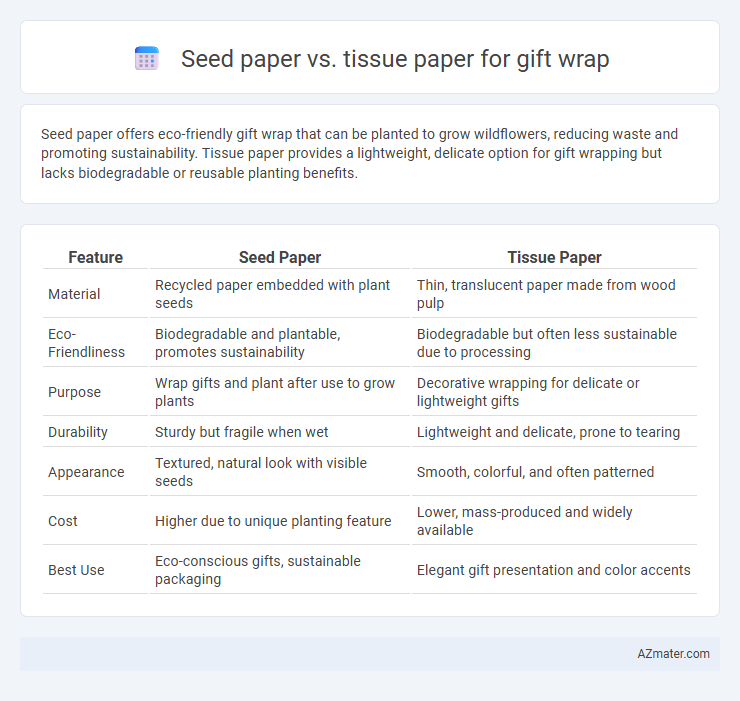Seed paper offers eco-friendly gift wrap that can be planted to grow wildflowers, reducing waste and promoting sustainability. Tissue paper provides a lightweight, delicate option for gift wrapping but lacks biodegradable or reusable planting benefits.
Table of Comparison
| Feature | Seed Paper | Tissue Paper |
|---|---|---|
| Material | Recycled paper embedded with plant seeds | Thin, translucent paper made from wood pulp |
| Eco-Friendliness | Biodegradable and plantable, promotes sustainability | Biodegradable but often less sustainable due to processing |
| Purpose | Wrap gifts and plant after use to grow plants | Decorative wrapping for delicate or lightweight gifts |
| Durability | Sturdy but fragile when wet | Lightweight and delicate, prone to tearing |
| Appearance | Textured, natural look with visible seeds | Smooth, colorful, and often patterned |
| Cost | Higher due to unique planting feature | Lower, mass-produced and widely available |
| Best Use | Eco-conscious gifts, sustainable packaging | Elegant gift presentation and color accents |
Introduction to Eco-Friendly Gift Wrapping
Seed paper offers a sustainable alternative to traditional tissue paper by embedding biodegradable seeds that grow into plants after use, reducing waste and promoting environmental benefits. Tissue paper, while lightweight and decorative, is often non-recyclable and contributes to landfill accumulation, lacking the regenerative attributes of seed paper. Choosing seed paper for gift wrap aligns with eco-conscious practices by combining aesthetics with sustainability and encouraging plant growth.
What is Seed Paper?
Seed paper is an eco-friendly wrapping material embedded with plant seeds that can be planted after use, promoting sustainability and reducing waste. Unlike traditional tissue paper, which is typically made from wood pulp and is biodegradable but not plantable, seed paper offers an interactive and renewable gifting experience. This innovative paper supports environmental conservation by encouraging recipients to grow flowers, herbs, or vegetables directly from the wrapping.
What is Tissue Paper?
Tissue paper is a lightweight, thin paper commonly used for gift wrapping and cushioning delicate items. Made from recycled fibers or virgin pulp, it provides a soft, translucent layer that enhances the presentation of gifts. Unlike seed paper, tissue paper lacks embedded seeds and is primarily designed for decorative and protective purposes rather than planting.
Environmental Impact: Seed Paper vs Tissue Paper
Seed paper is biodegradable and embedded with seeds that grow into plants, offering a sustainable, zero-waste alternative to conventional wrapping materials. Tissue paper, often made from virgin or recycled fibers, is biodegradable but typically lacks the regenerative benefits provided by the seed paper's plant-growing properties. Choosing seed paper for gift wrap significantly reduces environmental impact by promoting reforestation and minimizing landfill waste compared to traditional tissue paper.
Aesthetic Appeal and Texture Comparison
Seed paper offers a unique, eco-friendly aesthetic with a natural, rough texture that adds a rustic charm to gift wrapping. Tissue paper provides a smooth, lightweight feel and comes in vibrant colors, making it ideal for delicate, visually appealing presentations. Choosing seed paper enhances sustainability and tactile interest, while tissue paper delivers versatility and softness.
Gift Presentation: Pros and Cons
Seed paper enhances gift presentation by offering an eco-friendly, unique texture that surprises recipients with its plantable quality, creating a memorable unwrapping experience. Tissue paper provides a smooth, vibrant, and lightweight option ideal for cushioning delicate gifts, but lacks the sustainability and novelty of seed paper. Seed paper can be more expensive and less durable, while tissue paper is affordable and versatile but less impactful in terms of environmental messaging.
Biodegradability and Sustainability
Seed paper offers superior biodegradability compared to tissue paper, as it naturally decomposes and enriches the soil by growing into plants. This sustainable feature reduces environmental waste and promotes a circular lifecycle, aligning with eco-friendly gift wrapping practices. In contrast, conventional tissue paper, often treated with dyes and chemicals, decomposes slower and may contribute to landfill burden, making seed paper the greener alternative for environmentally conscious consumers.
Cost and Accessibility
Seed paper typically costs more than tissue paper due to its biodegradable materials and embedded plant seeds, which contribute to its eco-friendly appeal. Tissue paper is widely accessible, available in various colors and quantities at most retail stores, making it a budget-friendly option for everyday gift wrapping. While seed paper offers sustainability benefits, tissue paper remains a cost-effective and convenient choice for consumers prioritizing affordability and easy availability.
Creative Uses and Design Possibilities
Seed paper offers eco-friendly, plantable gift wrap that adds a unique, sustainable twist with embedded wildflower seeds promoting growth after unwrapping. Tissue paper provides versatile options with vibrant colors and delicate textures, enabling intricate layering, crumpling, and shaping for creative gift presentation. Both materials inspire innovative designs, with seed paper emphasizing environmental storytelling and tissue paper enhancing visual appeal through customizable patterns and translucency.
Choosing the Right Gift Wrap: Seed Paper or Tissue Paper?
Seed paper offers an eco-friendly and sustainable choice for gift wrap, embedding wildflower seeds that bloom when planted, making it ideal for environmentally conscious recipients. Tissue paper provides versatility with its lightweight, translucent texture, perfect for adding color and elegance to any gift presentation. Selecting between seed paper and tissue paper depends on whether the priority is sustainability with a living gift or classic decorative appeal for enhancing unboxing experiences.

Infographic: Seed paper vs Tissue paper for Gift wrap
 azmater.com
azmater.com